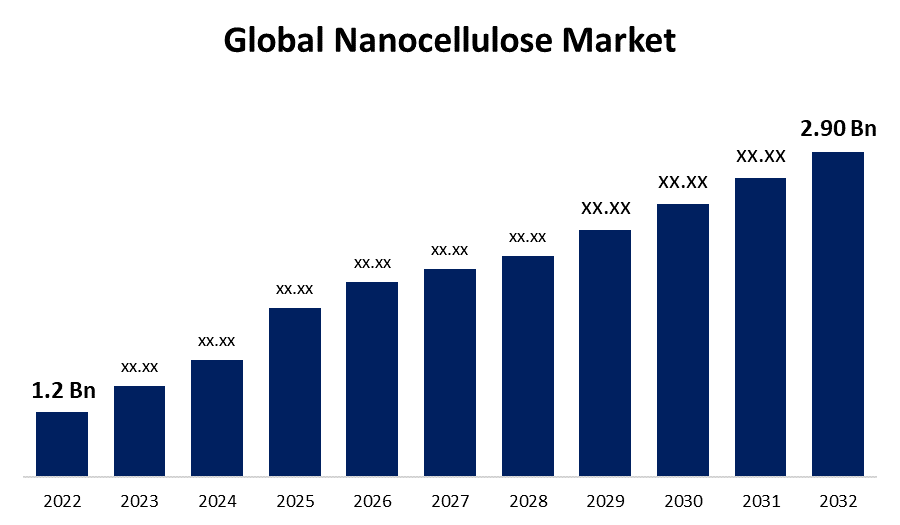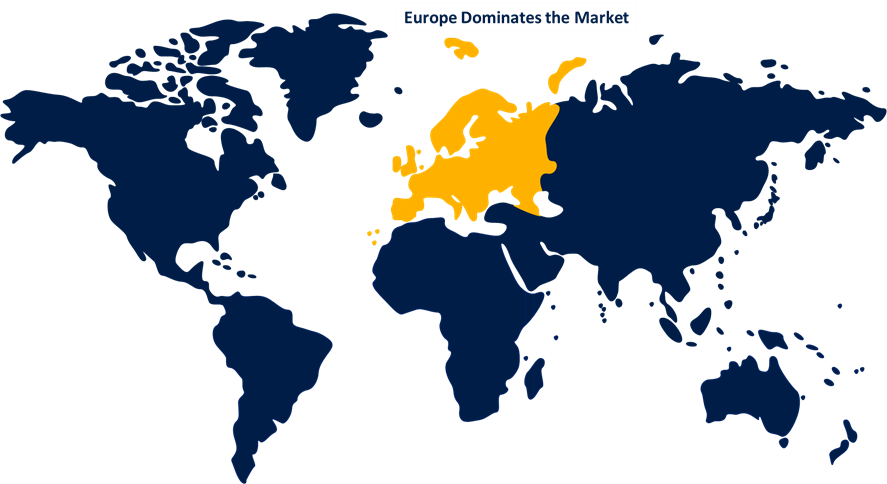Global Nanocellulose Market Size, Share, and COVID-19 Impact By Type (Cellulose Nanofibers, Bacterial Cellulose, Crystalline Nanocellulose), By Application (Pulp & Paper, Composites Manufacturing, Paints & Coatings, Electronics Sensors, Food and Beverage, Biomedical & Pharmaceuticals, Composites, Others), by Region (North America, Europe, Asia-Pacific, Latin America, Middle East, and Africa), Analysis and Forecast 2022 - 2032.
Industry: Chemicals & MaterialsGlobal Nanocellulose Market Insights Forecasts to 2032
- The Nanocellulose Market Size was valued at USD 1.2 Billion in 2022.
- The Market Size is Growing at a CAGR of 25.6% from 2022 to 2032
- The Worldwide Nanocellulose Market Size is expected to reach USD 2.90 Billion by 2032
- Asia Pacific is expected To Grow the fastest during the forecast period

Get more details on this report -
The Global Nanocellulose Market Size is expected to reach USD 2.90 Billion by 2032, at a CAGR of 25.6% during the forecast period 2022 to 2032.
Nanocellulose is a kind of cellulose made up of cellulose fibers or particles with a diameter of the nanometer. The major structural element of plant cell walls, cellulose is the most prevalent organic substance on Earth. Wood pulp, agricultural waste, and specific types of bacteria are just a few of the sources from which nanocellulose is created. Nanocellulose has special qualities that set it apart from other materials, including a large surface area, a high aspect ratio, and mechanical strength. These qualities make nanocellulose an exciting and adaptable substance with numerous potential uses in a variety of fields. Biodegradable materials, composites, filtration membranes, medicinal items, electronics, and food products were just a few of the industries where nanocellulose was finding use.
Impact of COVID 19 On Global Nanocellulose Market
The pandemic caused supply chains around the world to break down, which had an impact on how nanocellulose products were produced and distributed. Delays in the supply of raw materials and finished goods may have been brought on by restrictions on travel, lockdowns, and temporary closures of production facilities. Due to economic uncertainty and lower consumer spending during lockdowns and restrictions, demand for many businesses that use nanocellulose products, including packaging, textiles, and construction, decreased. This might have affected the demand for goods made with nanocellulose. The impact of the pandemic on diverse businesses may have impacted the demand for nanocellulose in numerous application areas. For instance, there might have been a rise in the demand for biodegradable and sustainable materials for medical and healthcare items, opening up new business prospects.
Global Nanocellulose Market Report Coverage
| Report Coverage | Details |
|---|---|
| Base Year: | 2022 |
| Market Size in 2022: | USD 1.2 Billion |
| Forecast Period: | 2022-2032 |
| Forecast Period CAGR 2022-2032 : | 25.6% |
| 2032 Value Projection: | USD 2.90 Billion |
| Historical Data for: | 2018-2021 |
| No. of Pages: | 275 |
| Tables, Charts & Figures: | 110 |
| Segments covered: | By Type, By Application, by Region, COVID-19 Impact Analysis. |
| Companies covered:: | Rise Innventia, Stora Enso, Oji Holdings Corporation, Nippon Paper Industries, FPInnovations, Fiberlean technologies, Celluforce INC, Borregard, Blue Goose Refineries, Axcelon Biopolymers Corporation, American Process Inc., and Other Key Venders. |
| Pitfalls & Challenges: | COVID-19 Empact, Challenge, Future, Growth, & Analysis |
Get more details on this report -
Key Market Drivers
Industries all around the world started exploring for eco-friendly replacements for conventional materials as environmental sustainability worries increased. Due to its biodegradability and reliance on renewable resources, nanocellulose is becoming more and more popular in a variety of applications. Packaging, composites, electronics, biomedical products, food, and other industries are all using nanocellulose. The market for nanocellulose grew as new and creative applications were found. Consumer knowledge of environmentally friendly products and their effects was expanding. Consumer preferences changed as a result, pushing businesses to use more environmentally friendly substitutes like nanocellulose.
Key Market Challenges
Costs of production are one of the major obstacles facing the nanocellulose industry. Resources and time may be used up in the extraction and purification of nanocellulose from raw materials like wood pulp or agricultural waste. Making nanocellulose more economically viable and competitive with other materials requires cutting production costs. Although nanocellulose may be made on a small scale in research labs, scaling up manufacturing to suit commercial demands is still difficult. It is a challenging endeavour that calls for additional study and funding to achieve dependable and large-scale production while keeping the required qualities of nanocellulose. Although nanocellulose has the potential for use in many different industries, some are further along in commercializing it than others.
Market Segmentation
Type Insights
The cellulose Nanofibers segment is dominating the market over the forecast period
On the basis of type, the global nanocellulose market is segmented into Cellulose Nanofibers, Bacterial Cellulose, Crystalline Nanocellulose. Among these, cellulose nanofibers segment is dominating the market over the forecast period. CNFs have strong mechanical characteristics, are stiff, and have a good aspect ratio. Due of these qualities, they are desirable as reinforcement for composite materials like polymers or cement, which improves mechanical performance. CNFs are environmentally benign and well-suited for applications requiring sustainable materials since they are made from renewable resources, such as wood pulp and agricultural waste, and because they are biodegradable. Numerous industries, including packaging, paper, textiles, electronics, medicinal goods, and more, use cellulose nanofibers. They are excellent for a variety of end purposes due to their adaptability and adjustable qualities.
Application Insights
Pulp and paperboard application segment holds the highest market share over the forecast period
Based on the application, the global nanocellulose market is segmented into Pulp & Paper, Composites Manufacturing, Paints & Coatings, Electronics Sensors, Food and Beverage, Biomedical & Pharmaceuticals, Composites, Others. Among these, pulp and paperboard application segment holds the highest market share over the forecast period. High tensile strength and stiffness are just two of the many mechanical qualities that distinguish nanocellulose, particularly CNFs. Nanocellulose can improve the mechanical performance of pulp and paperboard products, producing stronger and longer-lasting materials. Products made of pulp and paperboard can be made lighter while yet remaining strong and effective by using nanocellulose. This lightweighting effect can help achieve sustainability goals by lowering material use and transportation expenses.
Regional Insights
Europe is dominating the market with the largest market share over the forecast period

Get more details on this report -
Among all other regions, Europe is dominating the market with the largest market share over the forecast period. Many academic institutions, research centers, and businesses are actively trying to advance nanocellulose technology and applications, placing Europe at the forefront of nanocellulose research and development. Environmental responsibility and sustainability are highly valued in Europe. Nanocellulose is gaining popularity as a green substitute for traditional materials since it is a renewable and biodegradable substance that fits in well with the region's sustainability aims. The European nanocellulose market is broad, with goods used in packaging, textiles, paper, composites, electronics, and biomedical devices, among other industries.
Asia Pacific is witnessing the fastest market growth over the forecast period. Nanocellulose is increasingly being used in a variety of sectors, including packaging, textiles, electronics, automotive, construction, and biomedicine, throughout the Asia-Pacific area. The adaptability of nanocellulose and its capacity to improve the qualities of materials have piqued the interest of several industries. The Asia-Pacific area has seen a rise in the adoption of sustainability and a search for more environmentally friendly industrial practices and goods. Nanocellulose fits these sustainability goals because it is renewable, biodegradable, and environmentally favorable.
Recent Market Developments
- In August 2020, Cellulose foam, a light-weight, fiber-based foam material for protective packaging and cushioning, will be produced in a pilot facility that will be built by Stora Enso.
List of Key Companies
- Rise Innventia
- Stora Enso
- Oji Holdings Corporation
- Nippon Paper Industries
- FPInnovations
- Fiberlean technologies
- Celluforce INC
- Borregard
- Blue Goose Refineries
- Axcelon Biopolymers Corporation
- American Process Inc.
Market Segment
This study forecasts revenue at global, regional, and country levels from 2019 to 2032. Spherical Insights has segmented the global Nanocellulose Market based on the below-mentioned segments:
Nanocellulose Market, Type Analysis
- Cellulose Nanofibers
- Bacterial Cellulose
- Crystalline Nanocellulose
Nanocellulose Market, Application Analysis
- Pulp & Paper
- Composites Manufacturing
- Paints & Coatings
- Electronics Sensors
- Food and Beverage
- Biomedical & Pharmaceuticals
- Composites
- Others
Nanocellulose Market, Regional Analysis
- North America
- US
- Canada
- Mexico
- Europe
- Germany
- Uk
- France
- Italy
- Spain
- Russia
- Rest of Europe
- Asia Pacific
- China
- Japan
- India
- South Korea
- Australia
- Rest of Asia Pacific
- South America
- Brazil
- Argentina
- Rest of South America
- Middle East & Africa
- UAE
- Saudi Arabia
- Qatar
- South Africa
- Rest of Middle East & Africa
Frequently Asked Questions (FAQ)
-
1.What is the market size of Nanocellulose Market?The global Nanocellulose Market is expected to grow from USD 1.2 Billion in 2022 to USD 2.90 Billion by 2032, at a CAGR of 25.6% during the forecast period 2022-2032.
-
2.Who are the key market players of Nanocellulose Market?Some of the key market players of Royal Dutch Shell, ExxonMobil, PetroChina Company, British Petroleum (BP), Chevron Corporation, Sinopec, Indian Oil Corporation, BP, Fuchs Petrolub SE, QALCO, Schaeffer Manufacturing Co., Addinol Lube Oil GmbH.
-
3.Which segment hold the largest market share?Pulp and Paper segment holds the largest market share is going to continue its dominance.
-
4.Which region is dominating the Nanocellulose Market?Europe is dominating the Nanocellulose Market with the highest market share.
Need help to buy this report?